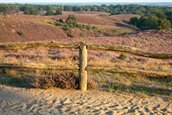Climate-proof Vallei-Veluwe region
In the Vallei-Veluwe region, a wide range of parties are successfully collaborating on climate adaptation. The Regional Climate Adaptation Core Team is initiating, encouraging, informing, facilitating, and coordinating collaboration in the region. This project serves as a best practice: how do you ensure efficient regional collaboration?
Project objective
The Vallei-Veluwe district water board is supporting the Regional Climate Adaptation Core Team. The Core Team has been set up to harness the power of collaboration in the region. Collaborating also cuts costs, in this case, costs entailed in implementing the agreements set out in the Delta Plan on Spatial Adaptation. Other goals include: saving on man hours, creating uniformity, and enabling the exchange of knowledge and data.
Implementation
The project has opted for regional collaboration between various organisations, among which are municipalities, provinces, the district water board, a drinking water company, the community health service, and the security regions. Its motto is “Collaboration Without Borders”. The organisational format of the collaboration and the activities that are collectively undertaken can be copied to other regions.
Results
- Developing a vision for Valley and Veluwe in 2120: a water-driven region.
- Organizing several editions of the Regional Climate Summit.
- Updating the Climate Impact Atlas for the Valley and Veluwe, including a rainwater probability map.
- The “Veluwe blue gold” video animation shows the importance of the groundwater system for the Veluwe area and how it is under pressure as a result of climate change. The animation shows that efficient collaboration is imperative in order to safeguard the water supply with the knowledge available. At the end, the film refers to the klimaatvalleienveluwe.nl website for in-depth articles and supporting tools.
- Climate change calls for spatial planning that is geared to water, the soil, and the subsoil. Nature and natural processes need to start playing a key role in spatial choices. In other words: policy plans and policy decisions need to be founded on the capacity and characteristics of the natural system. Logically, in order for us to be able to use the natural system as our point of departure, we first need to understand its structure. A proper first step would thus be to map the natural basic system in your region. The brochure entitled 'Vallei en Veluwe: natuurlijk een gevarieerde regio' (pdf, 12 MB) [Vallei-Veluwe, naturally a diverse region] paints a picture of the diversity in the Vallei-Veluwe natural system and shows how insight into its soil, water, and subsoil can constitute a sound basis for spatial developments in the region.
